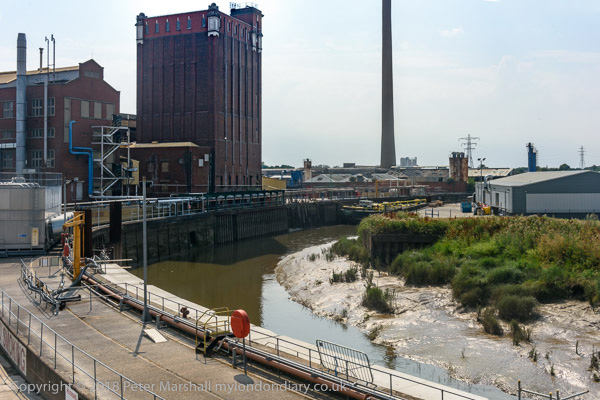Kenfig, Hedon Sand & River Hull – these pictures I made on Monday 21st August 1989 on a short section of the River Hull. I had hoped to walk along the footpath beside the river between Drypool Bridge and North Bridge.
The small tug Felix-Tow has got around a bit since it was built in the Netherlands in 1955. After working in Rotterdam the Ijssel came to Felixtowe in 1967 where it was renamed FELIX-TOW. I think it was fairly new to Hull where it was owned by Dean’s Tugs Ltd – and was still in service in 2008 – perhaps still now.
The vessel in the foreground is a coastal tanker belonging to the Hull based petroleum company RIX which still operates a fleet of coastal oil tankers, estuarial barges and crew transfer vehicles. Rix have oil storage tanks around a mile further up the river.
The company, as their web site relates, began in 1873 when Robert Rix, a sea Captain and Merchant Adventurer working in Hull set up in business building small coastal craft on the south bank of the River Tees in Stockton. In the 1900s the company bought steam ships and began operating them. The move into petroleum products came in 1927 when they began importing tractor vaporising oil and Lamp oil, packed in oak casks on their ships from Russia to the Humber.
The company expanded rapidly after the end of World War Two, supplying agricultural and commercial diesel across Yorkshire and opening petrol filling stations around Hull. The company has continued to grow and expand into new areas.
Barges like these in the middle of the picture were once very common, and were often moored three or four abreast in the Old Harbour downstream of Drypool Bridge, but by 1989 were becoming much less common, though some are still in use. Others have been converted to houseboats.
Barges like this might carry as much as 24 large lorries and could transfer goods from the docks to river wharves at much lower costs than road transport, with much lower pollution and carbon footprint. But of course they could only take goods to sites on navigable rivers and canals and so are much less flexible than road transport.
Hedon Sand, IMO 5185875 was a Grab Hopper Dredger built in 1954 close to Hull at Richard Dunston’s Hessle Yard. The ship had gross tonnage 677 tons, deadweight 813 tons and was around 50 metres long with a breadth of 10 meters. An 8 cylinder four-stroke msrine Ruston & Hornsby engine give it a top speed of 9 knots.
Known for most of its active life as Kenfig, it had been built for the British Transport Commission and was transfered to the British Transport Docks Board in Cardiff in 1963. It returned to the Humber and was used in dredging the Humber Dock Basin when Humber Dock was being converted to the Marina.
Mud is always a problem in the Humber and in the River Hull and I think dredging was always needed when the River Hull was still a commercial river. In recent years there seems to be far more mud in the river close to the mouth than I remember.
Kenfig was sold to Jones & Bailey Contractors Ltd, Hull in 1983 – they also owned another dredger, Grassendale and they renamed it Hedon Sand. In 1989 when I took these pictures the vessel was sold to be broken up in Hull.
I think some at least of these massive wooden beams had probably once supported parts of the riverside path I had hoped to walk.
Ahead of me I could see North Bridge but with extensive work taking place on the riverbank there was no way I could continue to walk along it and I had to retrace my steps to Drypool Bridge
On my way I took another picture of Hedon Sand before walking up to the road and going on into East Hull – where I took more pictures. More later.
Flickr – Facebook – My London Diary – Hull Photos – Lea Valley – Paris
London’s Industrial Heritage – London Photos
All photographs on this page are copyright © Peter Marshall.
Contact me to buy prints or licence to reproduce.














